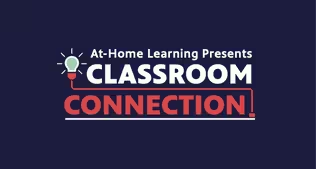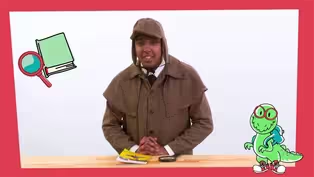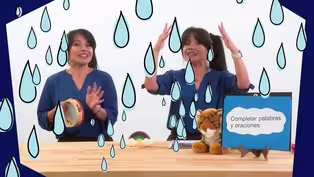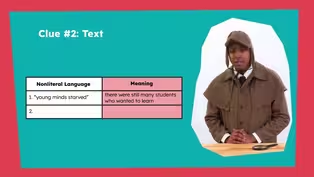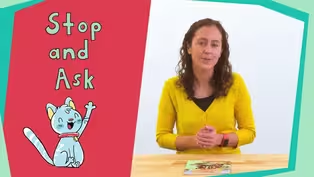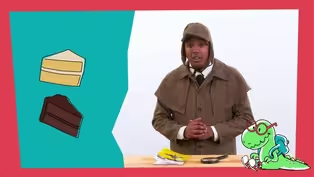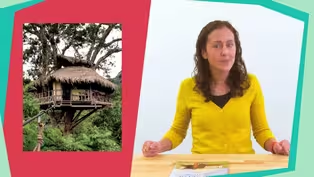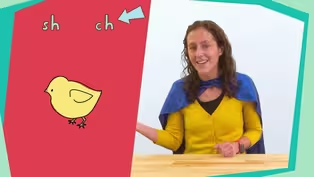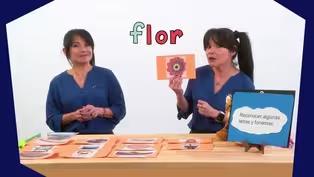
Episode 4 | Literacy Lessons
2/9/2021 | 28m 46sVideo has Closed Captions
Literacy lessons for early learners, led by NC teachers.
The first lesson is aimed at 3rd graders and teaches them how to determine meanings of words in text. The second lesson in this episode (aimed at PreK-K learners) helps students understand concepts of print, retell a simple story, and recognize letter Gg and its sound. Classroom Connection is your At-Home Learning companion where children love to learn. All lessons are led by NC educators.
Problems playing video? | Closed Captioning Feedback
Problems playing video? | Closed Captioning Feedback
At-Home Learning Presents: Classroom Connection is a local public television program presented by PBS NC

Episode 4 | Literacy Lessons
2/9/2021 | 28m 46sVideo has Closed Captions
The first lesson is aimed at 3rd graders and teaches them how to determine meanings of words in text. The second lesson in this episode (aimed at PreK-K learners) helps students understand concepts of print, retell a simple story, and recognize letter Gg and its sound. Classroom Connection is your At-Home Learning companion where children love to learn. All lessons are led by NC educators.
Problems playing video? | Closed Captioning Feedback
How to Watch At-Home Learning Presents: Classroom Connection
At-Home Learning Presents: Classroom Connection is available to stream on pbs.org and the free PBS App, available on iPhone, Apple TV, Android TV, Android smartphones, Amazon Fire TV, Amazon Fire Tablet, Roku, Samsung Smart TV, and Vizio.
Providing Support for PBS.org
Learn Moreabout PBS online sponsorshipMore from This Collection
Video has Closed Captions
Literacy lessons for early learners, led by NC teachers. (28m 46s)
Video has Closed Captions
Literacy lessons for early learners, led by NC teachers. (28m 46s)
Video has Closed Captions
Literacy lessons for early learners, led by NC teachers. (28m 45s)
Video has Closed Captions
Literacy lessons for early learners, led by NC teachers. (28m 45s)
Video has Closed Captions
Literacy lessons for early learners, led by NC teachers. (28m 46s)
Video has Closed Captions
Literacy lessons for early learners, led by NC teachers. (28m 46s)
Video has Closed Captions
Literacy lessons for early learners, led by NC teachers. (28m 45s)
Video has Closed Captions
Short Description: Literacy lessons for early learners, led by NC teachers. (28m 45s)
Video has Closed Captions
Literacy lessons for early learners, led by NC teachers. (28m 45s)
Video has Closed Captions
Literacy lessons for early learners, led by NC teachers. (28m 45s)
Video has Closed Captions
Literacy lessons for early learners, led by NC teachers. (28m 45s)
Video has Closed Captions
Literacy lessons for early learners, led by NC teachers. (28m 45s)
Providing Support for PBS.org
Learn Moreabout PBS online sponsorship[cheerful upbeat music] ♪ [says "hello" in Spanish, Chinese, and German] - And good morning, my super learners.
You know one good thing about being at home is that I get to be right here with you learning about some amazing topics.
Are you ready?
[applauding] I like that.
Let's see what we got to learn in the classroom today.
Let's connect.
- Hey everyone, Ms. Shannon and I'm so happy to see you again.
Our friend the Sun is back too.
Hi again Sun.
Now that we're all together.
Can you remember what we worked on last time?
We started reading "Sun!
One in a Billion," written by Stacy McAnulty and illustrated by Stevie Lewis.
We use strategies from our word detective toolkits to help us find important words in the book.
And we learned that to find important words, we can look for repeating words, find words that describe the topic, notice names and see bold print.
The words we explored were magnificent, important, star, massive, luminous, Milky way, galaxy, billion, EarthLink, gravity, and solar system.
This time we're going to keep finding important words and we're also going to take it one step further and think more about how to figure out what they mean.
We can often do that by reading all around the word.
I'll show you how.
Let's review what we have already read so far.
First we met the Sun and realized in this book, they're true facts along with some fiction which makes it really fun to read.
We found out that the Sun is one of many stars in the universe and that it helps us in many ways.
It is the center of our solar system and the planets spin around it.
That's where we stopped.
So today we'll keep going from here.
As we read, we'll keep using these strategies from our toolkit to find important words and we'll add more strategies from our toolkit to help us figure out what they mean.
Let's get started.
Those other stars are far, far away from earth which makes them look teeny tiny and not so important.
I'm close, a mere 93 million miles from earth.
To an earthling, I look like this, but to Neptunian I'm 2,795 million miles away.
And I look like this.
If there were enough Neptunians, there's no known life on Neptune.
So 93 million miles away seems like a long distance.
But when we compare that to 2,795 million miles away, it seems much smaller.
I saw that word earthling again, so it's a good thing we found that one last time.
Let's keep going.
Watch me show you how to use some of our word detective strategies as I read.
Technically I'm a yellow dwarf star but I'm still a big, big deal.
If I were the size of a basketball, earth would be smaller than a grain of sand.
You could fit about 1 million earths inside me.
So what words seems important to know about the Sun?
Dwarf, I can tell that this word is important because the author is using it to describe the whole topic of the book, the Sun.
This is one of our key word finding strategies from our toolkits.
We definitely want to make sure we understand the meanings of the words the author uses to describe the main thing that the book is all about.
So how can we figure out what it means?
Let's go back to our toolkit.
Last time it gave us strategies to find important words and this time it will give us strategies to figure out what those important words mean.
Let's pull one out and see what it says.
Maybe it'll help us figure out what dwarf means.
Look for antonym.
Let me try this strategy.
Maybe if I read all around the word to find antonyms or opposites then I can find clues to help me figure out what dwarf means.
Right after saying it's a yellow dwarf star, the Sun says, "But I'm still a big, big deal."
The word but is a clue that the text might give me an antonym or opposite.
Then it says it's still a big, big deal.
The opposite of big is small.
So a dwarf star must be smaller than some other stars.
That means some stars are bigger than our Sun.
Now it's your turn to help me find and analyzed keywords as we read the next two pages.
We just compared size and distance.
So now let's compare temperature.
But you can't fill me with Earth's because I'm hot stuff.
Compare a hot summer day, 90 degrees Fahrenheit, a pizza oven, 700 degrees Fahrenheit, the orange yellow flames in a campfire, about 2000 degrees Fahrenheit, me, about 10,000 degrees Fahrenheit on the surface.
I can melt diamonds.
Me at my center, 27 million degrees Fahrenheit.
Whoa, that's hot.
Which word on this page seems important.
Remember to use our four strategies, look for repeating words, find words that describe the topic, notice names and see bold print.
[upbeat music] Yes, the word surface seems important because the author is using it to describe part of our topic, the Sun.
That's our second strategy.
Now what might it mean?
And how can we figure that out?
I'm going to pull another strategy out of our toolkit to see if it can help us.
Use the words and pictures together.
let's try that.
In the picture he word surface is written on the outside layer of the Sun.
Just like the word center is written in its middle.
So the word surface must mean the outer most layer of something.
Wow.
The author and illustrator really did a great job of getting these words and pictures to work together to help us understand them.
So now we have two strategies from our toolkit that can help us figure out what important words mean.
We can look for antonyms and we can use the words and pictures together.
Let's see if we can find more keywords.
Ancient earthlings thought I circled the earth.
Can you imagine me revolving around earth?
And some might think that I sit in the sky all day and all night, but I got moves baby, I'm spinning.
And because I'm not solid, my middle moves faster than my top and bottom.
Don't try this at home.
And the middle moves about 25 earth days to rotate and the top and bottom take about 36 earth days to rotate.
Do you see any new keywords?
[upbeat music] I'm noticing the word revolve because it repeats.
It's on this page and was also on another page that we read previously.
Our first toolkit strategy for finding important words tells us to look for repetition.
And this one definitely repeats.
Now, how can we figure out what it means?
Can you try to use one of the two strategies from our toolkits that helps us find the meanings of important words?
[upbeat music] I found that the second strategy works well here.
We can use the pictures and words together to figure out what revolve means.
The text says ancient earthlings thought I circled the earth.
Can you imagine me revolving around earth?
So it seems like circled and revolve mean the same thing.
And the Sun is just restating the same idea in a different way in each of those sentences.
If we check the picture, we can see the circles drawn around the earth to show the planets moving in a circular motion around it.
And the Sun is frowning because it... And we know that's not accurate.
The planets revolve around the Sun.
The pictures and words working together help us understand that revolve means to move in a circular motion around something.
Hey, get out of here planets, I'm not the Sun, don't revolve around me.
Let's keep reading.
I'm not only important, I'm generous.
and good-looking.
Sunrises, Sunsets, Northern lights, Southern lights, sit back and enjoy the show.
[instrumental music] Now what important words can you find on the next pages?
Remember to use the strategies from our word detective toolkit.
Sometimes I like to be mysterious and sneak away for a few minutes, solar eclipse, but don't worry I'm just behind the moon.
While I'm astronomically bigger than the moon, 400 times wider, the moon is astronomically closer to earth almost 400 times closer.
Did you find an important word?
[instrumental music] I found solar eclipse.
We know that solar eclipse is important because it describes something that our topic the Sun does.
So we can figure out that using this strategy, finding words that describe the topic.
Now let's figure out what it means.
Go ahead and use one of these strategies to find the meaning.
[instrumental music] Did you use the text and pictures together?
That's what I did.
It says that the Sun is behind the moon and that's exactly what we see in the picture of a solar eclipse.
The Sun is peeking out from behind the moon.
Let's keep reading.
[instrumental music] My neighbor stars have fancy names, meet Proxima Centouri, alpha Centouri A and alpha Centouri B.
Me, I need just three letters.
Give me an S, give me a U, you give me an N, what does that spell Sun, Sun, Sun.
He's our star, light and heat from afar.
Please note that's a capital S I am important.
Let's find another key term that helps us understand the Sun on the next page.
Not to hog the spotlight but I've still got it.
I'm the same hot, bright star I've always been.
A stable star is a good star.
You don't want your Sun getting hotter or cooling off.
That would be really messy.
Which word seems most important.
Remember to use the strategies from our toolkit.
Look for words that repeat, find words that describe the topic, notice names and see bold print.
[instrumental music] Yes stable.
We know that word is important because it's used to describe our topic.
So we definitely wanna make sure we know what it means.
Now, which strategy will help us figure out the meaning?
[instrumental music] Let's try antonyms.
The text tells us that the opposite of stable is a big change, like getting hotter or cooling off.
So stable must mean staying the same.
Like here the Sun's temperature is stable.
The newspapers in the background show us bad things that could happen if the Sun were unstable.
Stars fall apart, meltdown, total collapse.
Let's keep reading, we're detectives.
[instrumental music] So grab your shades, I plan to be in the biz for another 5 billion years.
You and me, we've got a bright future together.
And on these last two pages there are tons of facts about the Sun.
What a great place to find more information.
We don't have time to read all of it right now but I do want to read you a note that the author wrote to us the readers.
Here we'll learn one last strategy from our toolkit to help us figure out what words mean.
Dear reader, I love our Sun and I think he deserves a name.
Perhaps Buck or Reginold or Mostest importanus Centouri.
Earth, our very own planet awesome would not exist without Sun and without her, there would be no chocolate chip cookies, picture books or frisky puppies which are a few of my favorite things.
So I guess I need to say, thank you Sun with a capital S. Thank you for light, heat, energy, and the gravity that keeps earth revolving at the most perfect distance from your super hot surface.
Too close, we'd be scorched, too far away, we'd freeze.
You're one in a billion, with gratitude Stacy McAnulty author and frequent wearer of Sunblock.
I'm not quite sure what frequent means.
I'm not noticing any antonyms and there aren't any pictures that I can use with the words to help me.
What can I do?
I better check my toolbox.
[instrumental music] Check a dictionary.
Oh, the last strategy we we'll learn today for figuring out what words mean is to look them up in a dictionary.
Sometimes the context clues we find when we read all around the word like antonyms and using words and pictures together don't give us enough information to figure out what a word means.
When that happens, we can look the words meaning up in a dictionary.
And when I look up frequent, I see that it means something done often.
So if the author says she's a frequent wearer of Sunblock that means she wears it a lot.
Today, we practiced finding and figuring out important words in a text.
When we find a text that provides lots of facts we should think about which words are most essential to understanding the topic.
To do this, we should look for words that repeat, words that describe our topic, notice names and see bold print.
We also used our word detective toolkit to find strategies to figure out what important words mean.
We can find antonyms, use the words and pictures together or check a dictionary.
See you next time when we continue to explore this really fun and interesting book, bye.
[upbeat music] - When I was reading today about outer space, I read that 1 million earths could fit inside the Sun.
That's a really big Sun, but it looks so small from earth because it's so far away.
I love outer space.
What's your favorite thing to read about?
We have an awesome literacy lesson for you today.
So watch out, 'cause here it comes.
[upbeat music] - Hello, super learners.
My name is Ms. Jennifer, and I'm so excited that you were here to learn with me today.
You will need a piece of paper, a pencil and a stuffed animal for today's lesson.
Ask a trusted adult to help you find these items.
While you're getting your supplies, I'm gonna grab mine as well.
I'll be right back.
[upbeat music] Okay.
I'm back now and I see you are too.
We have our supplies, so let's go.
Today we are gonna re-read the story, "Puppy paints."
We will practice retelling the story and review the parts of a book.
We will also review the letter P and learn about the letter G. Are you ready?
[upbeat music] All right super learners, let's get started.
First let's review the letter P. The letter P looks like this.
Do you remember how to write it?
Show your stuff friend how to write the letter P in the air.
To write the letter P, we start at the top, make a straight line down then jump back to the top and make a curved line to the right and back to the straight line.
Great job.
The letter P makes this sound P. Say it to your friend P. Now turn back to me and say it P. Great job saying P sound.
Now let's look at our circle map and see if we can spot words that start with P. [instrumental music] We have our pizza.
Tell your friend what is the first sound in pizza?
[instrumental music] Right?
My pizza is yummy.
How was your pizza?
[instrumental music] Tell your stuff friend, what does the first sound of the word puppy?
[instrumental music] Right, Let's pant like a puppy [panting].
Tell your friend what is the first sound in paintbrush?
[instrumental music] Right.
Let's paint together.
My paint is purple.
What color is your paint?
Tell your stuff friend, what is the first sound in pickle?
[instrumental music] Right?
Let's eat a pickle [chewing].
Great job.
I'm so glad that you remember the letter P and its sound.
Now we are gonna learn about the letter G. The letter G looks like this.
To write the letter G, we start at the top, we make a curve line down to the left, then we come back up and slide to the left.
Let's all get out our magic finger.
Use your magic finger in the air to write the letter G with me.
We're gonna start at the top, make a curve line down to the left, then come up and slide to the left.
Great job.
The letter G makes this sound G. Say it to your stuff friend G. Now turn and say it to me G. Good job saying the G sound.
We're gonna use a graphic organizer called a circle map to help us think about the letter G and the things that begin with it sound G. You can make your own circle map using your piece of paper and a pencil or crayons.
First, you're going to draw a small circle in the middle of your page, right?
What's you're thinking about in the circle, today we're thinking about the letter G, so you should write the letter G in the small circle.
Then you're going to come to the top of your paper, make a large circle around your small circle.
And now you have a circle map.
Super learners, I need your help so that we can fill in our circle map with things that begin with the sound G. I will give you a clue and you try to guess what I'm thinking.
Are you ready?
[upbeat music] Great.
I'm thinking of a food that I love to eat that begins with the sound G sound.
It is a round fruit that comes in a bunch.
Tell your stuff friend what food I'm thinking of.
[upbeat music] Did you say grapes?
That's right.
Can you show me how it looks when you eat grapes?
Yum.
Those were tasty.
Now I'm going to write the word grapes on the circle map.
Grapes.
What is the first sound in the word grapes?
[upbeat music] That's right, G. Which letter do we need to spell that sound?
[upbeat music] That's right.
We spell the sound G with the letter G. Then we need R-A-P-E-S. Now, I'm thinking of something that is part of a fence.
It opens and closes to allow people to go in and out.
Tell your stuff friend what I'm thinking of.
[instrumental music] Did you say a gate?
That's right.
Great thinking.
Can you show your friend how to open and close a gate?
it's kind of like opening and closing a door.
Now I'm going to write the word gate on the circle map gate.
What is the first sound in the word gate?
[upbeat music] Did you say G, that's right, G. Tell your stuff friend which letter we need to spell that sound.
[upbeat music] That's right.
We spell the sound G with the letter G. Then we need A-T-E. That spells gate.
For my last clue, I'm thinking of a color.
It is the color of grass in the spring.
Tell your stuff friend what I'm thinking of.
[instrumental music] Did you say green?
That's right, great thinking.
Can you show your stuff friend something green in your home.
[instrumental music] Now I'm gonna write the word green on the circle map.
Green, what is the first sound in the word green?
[instrumental music] Did you say G?
That's right G. Tell your stuff friend which letter we need to spell that sound.
That's right, we spell the sound G with the letter G. Then we need R-E-E-N. That spells green.
Wow super learners.
Our circle map looks great.
Look at all those G words that we know.
Thanks for helping.
Now let's get ready to read our book.
Here is our book.
We read "Puppy Paints" the last time we were together.
Today, we will be using retelling cards to help us retell the story.
A book has several parts.
This part is called the front cover.
It has the title, tells the author and illustrator and has a picture to show us what story is about.
This is the back cover of the book.
Let's practice to see if you can tell me which is the front cover and which is the back cover.
[instrumental music] Tell your stuff friend, am I showing you the front cover or back cover?
How do we know?
It has the title, author and illustrator and a picture.
Tell your stuff friend, am I showing you the front or back cover?
[instrumental music] That's right.
This is the back cover.
How do we know?
It does not have the title, author or illustrator on it.
Let's turn the page and read our story.
As we read, pay close attention to two things.
First, listen to what puppy sees and paints.
After we read the story, we're going to remember all of the things puppy sees and paints.
Next if you hear a P sound in your word, touch your ear and tell your friend P. Puppy sees a flower, puppy paints a flower.
Puppy sees a doll, puppy paints a doll.
Puppy sees a cat, puppy paints a cat.
Puppy likes his paintings.
We heard a lot of P sounds in that story, like puppy and paints.
Now let's use the retelling cards to tell what happened in the story.
If you forgot something, you can always go back to the story to help you remember.
First puppy saw a flower.
I'm gonna put the retelling card that shows puppy looking at a flower on the board, in the first space.
[instrumental music] This retailing card shows the first thing that happened.
Then puppy painted a flower.
I'm gonna put the retelling cards showing puppy painting a flower in the next box.
Tell your stuff friend what happened in the next part of the story.
[gentle music] Did you tell your friend that puppy saw a doll?
That's right, now we need our retelling cards showing puppy looking at a doll.
What happened next?
Tell you stuff friend.
[gentle music] Did you say that puppy painted a doll.
That's right.
So now we need the retelling cards showing puppy painting a doll.
Let's go back in the story and see what happened next.
Tell your stuff friend what happened in this part of the story?
[gentle music] Did you say puppy saw a cat?
That's right.
I'm gonna put the retelling cards showing puppy looking at the cat.
What happened next?
Did you say puppy painted a cat?
That's right.
So now I need the retelling card showing puppy painting a cat.
Now tell your friend what happened at the end of the story.
[gentle music] That's right.
Puppy liked his painting so much, he hung them on the wall.
Let's put our picture showing puppy hanging on the wall.
You did such a great job retelling the story.
All right super learners, that is the end of our lesson for today.
Thank you so much for being with me.
As we reviewed the letter P and learn the letter G. We also learned about the parts of a book.
I hope you enjoyed retelling puppy paints.
Keep looking for the letters, P and G. When you find new P or G words, add them to your circle maps.
I'll see you next time.
- Wow.
Time sure does fly when you're learning and having fun.
I wanna thank you so much for joining us today, on PBS, North Carolina.
You are so smart, so special and so fun to be with.
Wishing you peace, love, and learning, my friends.
[cheerful upbeat music] ♪
Support for PBS provided by:
At-Home Learning Presents: Classroom Connection is a local public television program presented by PBS NC
